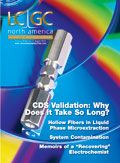The "Chrommunity" Welcomes Two Distinguished New Members
LCGC North America
For some time now, readers have probably noticed the green "Chromacademy" logo at the end of their favorite columns and research articles here in the print issue of LCGC North America.
For some time now, readers have probably noticed the green "Chromacademy" logo at the end of their favorite columns and research articles here in the print issue of LCGC North America. Hopefully, many of you have migrated over to this online e-learning resource at some point to see what it has to offer. If so, you would have noticed that the "Chrommunity" social networking section of Chromacademy has been up and running — and flourishing — for some time now, with nearly 1700 members networking, sharing information, and generally working together to improve productivity.
As of this month, the Chrommunity has received a high-profile boost with the addition of two new, regular bloggers: Kevin Schug, University of Texas at Arlington, and Jared Anderson, University of Toledo. The winners of the 2009 and 2010 LCGC Emerging Leader awards, respectively, Dr. Anderson and Dr. Schug represent a potent one-two punch of chromatographic research. With Dr. Anderson specializing in GC research and most recently eulogizing the late Leslie Ettre in his blog, and Dr. Schug specializing in LC–MS and HILIC research, the Chrommunity now has two of the best and brightest young stars in the field acting as resources for its members.
We invite you to visit http://chrommunity.chromacademy.com/ and view the latest blogs from these industry experts and others for yourself. Once there, you'll also find animated discussion threads on everything from the use of GC–MS in the Gulf Oil Spill to the latest applications of chromatography in the world of art and artistic forgeries. Social networks may once have been relegated to the world of teenagers and celebrity-watchers, but now LCGC has brought this unique resource to the lab with a network of hard-core researchers sharing knowledge. We hope you will find it as useful as the other thousands of chromatographers who currently utilize it every day.

David Walsh

David Walsh
Editor-in-Chief

Distinguishing Alcohol- from Non-Alcohol-Associated Liver Cirrhosis with LC-MS
May 7th 2025A pilot study investigating whether nicotinamide adenine dinucleotide kinase (NADK) expression is selectively diminished in alcohol-associated liver cirrhosis (AC), as well as evaluating its potential as a biomarker for this condition, measured AC and non-AC (NAC). Nicotinamide adenine dinucleotide (NAD+) and nicotinamide adenine dinucleotide phosphate (NADP+) levels in human liver samples were measured using liquid chromatography-mass spectrometry (LC-MS).

.png&w=3840&q=75)

.png&w=3840&q=75)



.png&w=3840&q=75)



.png&w=3840&q=75)









